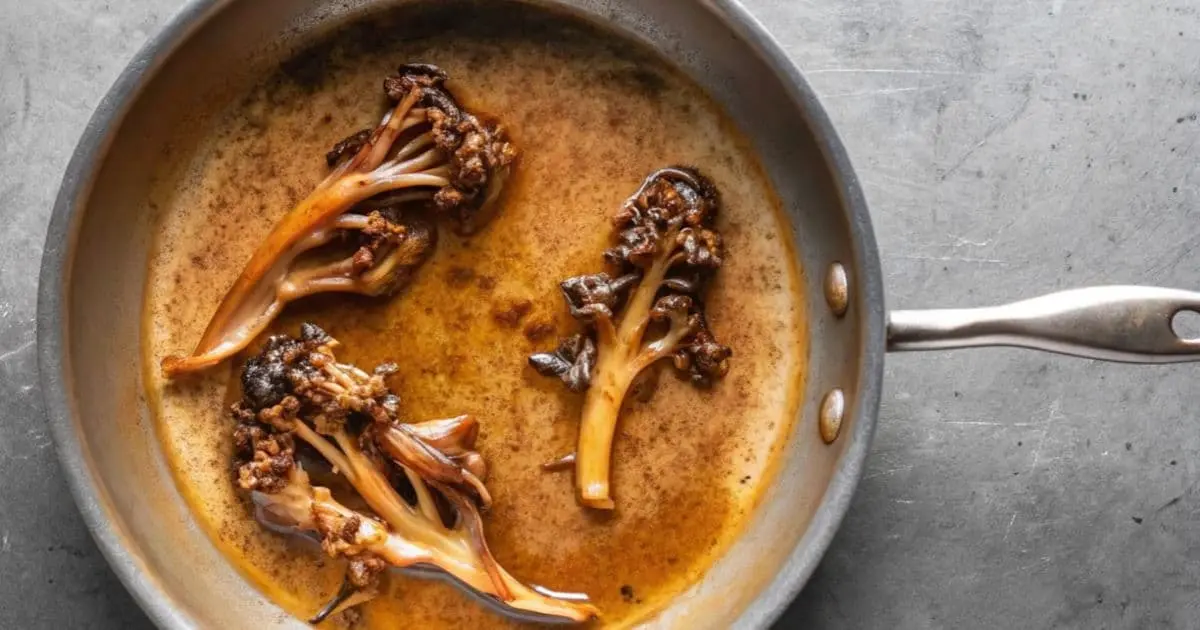Looking for a delicious and nutritious dish? This maitake recipe is just what you need! Maitake mushrooms, known for their rich umami flavor and health benefits, make for an incredible addition to any meal. Whether you’re looking for a quick weeknight dinner or a flavorful side to complement your main course, this recipe is versatile, easy to prepare, and packed with antioxidants. Perfect for those on plant-based or gluten-free diets, this maitake recipe will quickly become a go-to in your kitchen. Ready to create a mouthwatering meal that’s both healthy and satisfying? Let’s get started!
Table of Contents
Key Benefits of This Maitake Recipe
If you’re looking for a meal that’s both delicious and packed with nutrients, this maitake recipe has you covered. These mushrooms aren’t just flavorful; they’re also incredibly good for you. Let’s dive into the key benefits that make maitake mushrooms a must-have in your diet.
- Nutrient-Dense and Low-Calorie: Maitake mushrooms are a great source of fiber, vitamins, and minerals like potassium, iron, and vitamin D. They’re also naturally low in calories, making them an excellent choice if you’re looking for a healthy, filling meal without the extra calories.
- Immunity-Boosting: Did you know maitake mushrooms have powerful antioxidant properties? They’re known to help support your immune system, thanks to their high levels of beta-glucans—compounds that boost the body’s ability to fight off infections and diseases. Perfect for when you’re looking to stay healthy year-round!
- Promote Digestive Health: With their high fiber content, maitake mushrooms are a great ally for digestion. Including them in your meals can help support healthy digestion and promote gut health, making this recipe a perfect choice for those seeking a gut-friendly meal.
- Versatile and Flavorful: Not only are they nutritious, but maitake mushrooms also offer a rich umami flavor, which makes them a perfect substitute for meat in plant-based or vegetarian dishes. The texture is hearty and satisfying, making it an ideal addition to a variety of recipes—from stir-fries to pasta dishes.
- Antioxidant-Rich: Maitake mushrooms are rich in antioxidants, which help fight oxidative stress and protect your cells from damage. This makes them a great addition to any diet focused on anti-aging or reducing inflammation.
Incorporating maitake mushrooms into your meals isn’t just about enhancing flavor; it’s about boosting your health in a natural, delicious way. So, whether you’re enjoying them as a side dish or the star of your plate, you can feel good knowing you’re nourishing your body with each bite!
Ingredients for Your Perfect Maitake Recipe
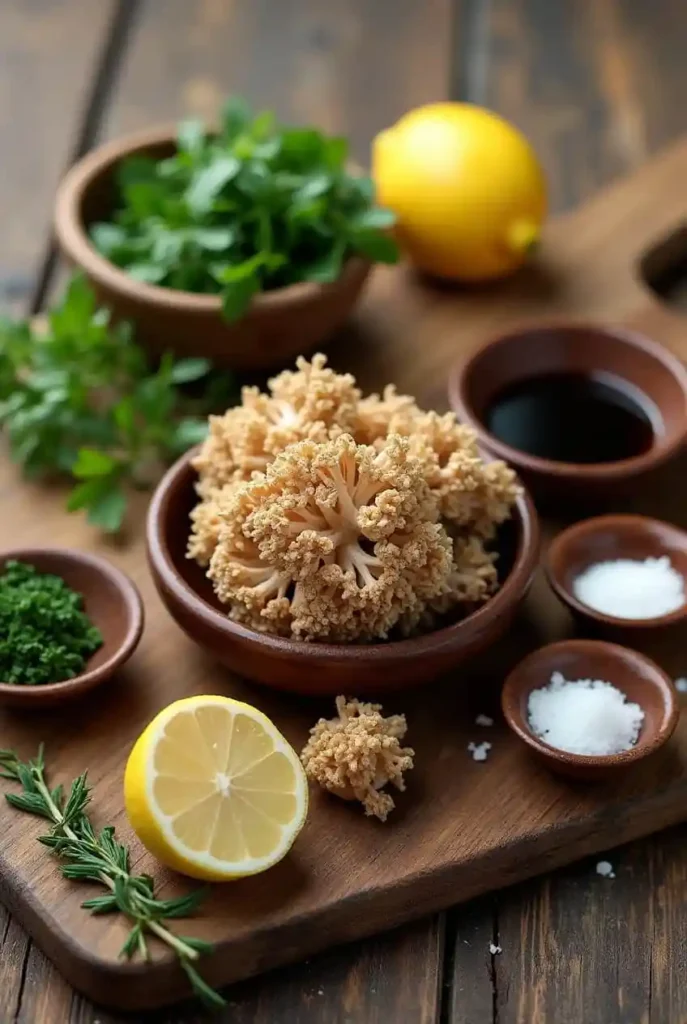
To make this maitake recipe truly shine, you’ll need a few simple ingredients that bring out the mushroom’s natural, rich flavor. Here’s what you’ll need to gather:
Main Ingredients:
- 200g Fresh Maitake Mushrooms – Cleaned and torn into bite-sized pieces. Fresh maitake mushrooms are essential for the best flavor and texture. If you can’t find fresh, you can substitute with dried, but be sure to rehydrate them before cooking.
- 30ml Olive Oil – For sautéing the mushrooms and bringing out their earthy flavor.
- 2-3 Cloves Garlic – Finely minced. Garlic complements the umami of maitake mushrooms perfectly.
- 30ml Soy Sauce (or Tamari for a gluten-free option) – This brings a rich, umami-packed flavor to the dish.
- 1 teaspoon Lemon Zest – Adds a bright, citrusy note that balances the richness of the mushrooms.
- Salt and Pepper – To taste. These simple seasonings elevate the overall flavor and bring all the ingredients together.
Optional Add-ins for Extra Flavor:
- Fresh Herbs – A few sprigs of thyme or rosemary, chopped. These herbs pair beautifully with maitake mushrooms and add an extra layer of fragrance.
- Chili Flakes – A pinch, if you like a little heat in your dish.
- 1 tablespoon Nutritional Yeast – For a vegan “cheesy” flavor boost, sprinkle over the finished dish.
Why These Ingredients Work Together:
Each ingredient in this maitake recipe serves a specific purpose. Olive oil creates a nice base for the mushrooms to sauté in, allowing them to brown and develop their rich flavor. Garlic and soy sauce bring that irresistible savory umami note, while lemon zest offers a refreshing brightness that lifts the dish. Together, these simple ingredients highlight the natural, earthy flavor of the maitake mushrooms without overpowering them.
Instructions for Cooking Your Perfect Maitake Recipe
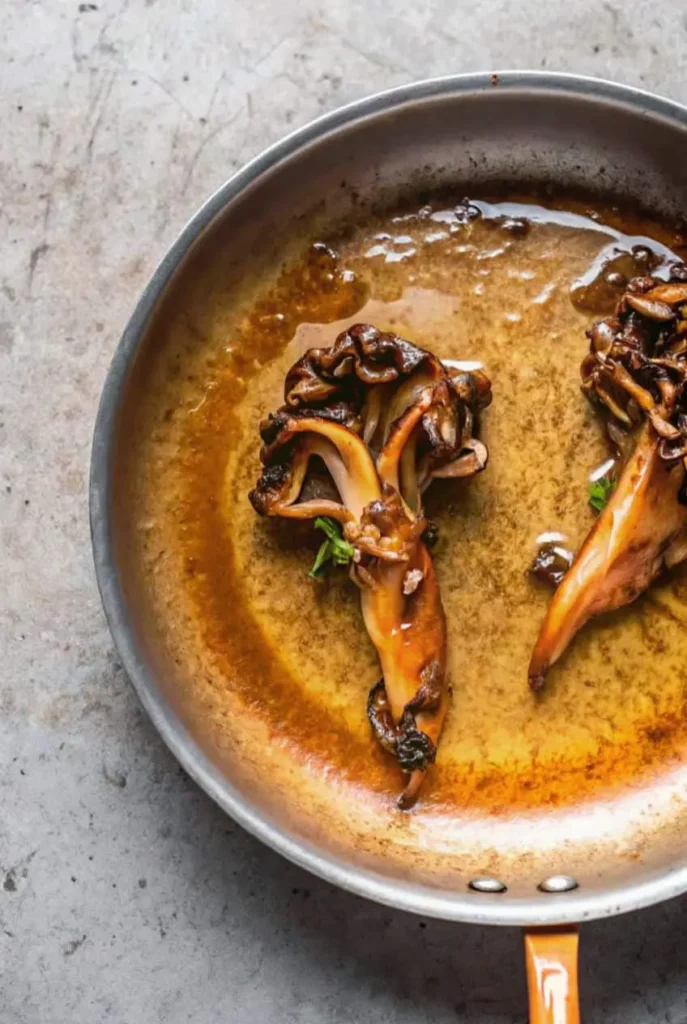
Let’s break it down step by step! Here’s how to cook your maitake mushrooms to perfection:
1. Prepare the Mushrooms
- Gently clean the maitake mushrooms using a damp cloth or soft brush to remove any dirt.
- Avoid soaking the mushrooms in water as they absorb moisture, which can change their texture.
- Tear the mushrooms into bite-sized pieces for even cooking and to get that perfect texture.
2. Heat the Pan
- Place a large skillet or frying pan on medium heat and pour in 30ml olive oil.
- Allow the oil to heat for 1-2 minutes until it shimmers, signaling it’s ready for the mushrooms.
3. Sauté Garlic and Maitake Mushrooms
- Add the minced garlic to the hot oil and sauté for about 30 seconds until it becomes fragrant (be careful not to burn it).
- Add the torn maitake mushrooms to the pan. Stir occasionally and cook for 5-7 minutes, allowing the mushrooms to brown and become tender. The mushrooms will release their moisture, and the edges will start to caramelize, adding extra flavor.
4. Add Soy Sauce and Lemon Zest
- Once the mushrooms are golden brown, pour in 30ml soy sauce (or tamari if you’re going gluten-free) and toss the mushrooms to coat.
- Add 1 teaspoon lemon zest and stir to combine. The zest adds a refreshing citrusy note that balances the savory richness of the mushrooms.
- Continue to cook for another 1-2 minutes until the sauce reduces slightly and the mushrooms are well-coated.
5. Season and Finish
- Season with salt and pepper according to your taste, adjusting until it’s just right for your palate.
- If you like a bit of heat, sprinkle in chili flakes for a touch of spice.
- For a cheesy, vegan option, sprinkle 1 tablespoon nutritional yeast over the cooked mushrooms to add a nutty, cheesy flavor.
6. Serve and Enjoy
- Once the mushrooms are tender and flavorful, transfer them to a serving dish.
- Serve them as a side dish, over rice, or on toast for a quick and satisfying meal.
Pro Tips:
- Don’t overcrowd the pan! If there are too many mushrooms in the pan, they’ll steam rather than brown. Cook in batches if necessary for the best texture.
- Let them caramelize! The longer the mushrooms cook, the more flavor they develop. Don’t rush this step!
- Fresh garlic makes a big difference in bringing out the savory, rich flavor of the maitake mushrooms.
And that’s it—your perfect maitake mushrooms are ready to be enjoyed! Whether as a stand-alone dish or paired with your favorite sides, this recipe is sure to impress with its deep, umami-rich flavor. Enjoy!
Pro Tips and Variations for Your Maitake Recipe
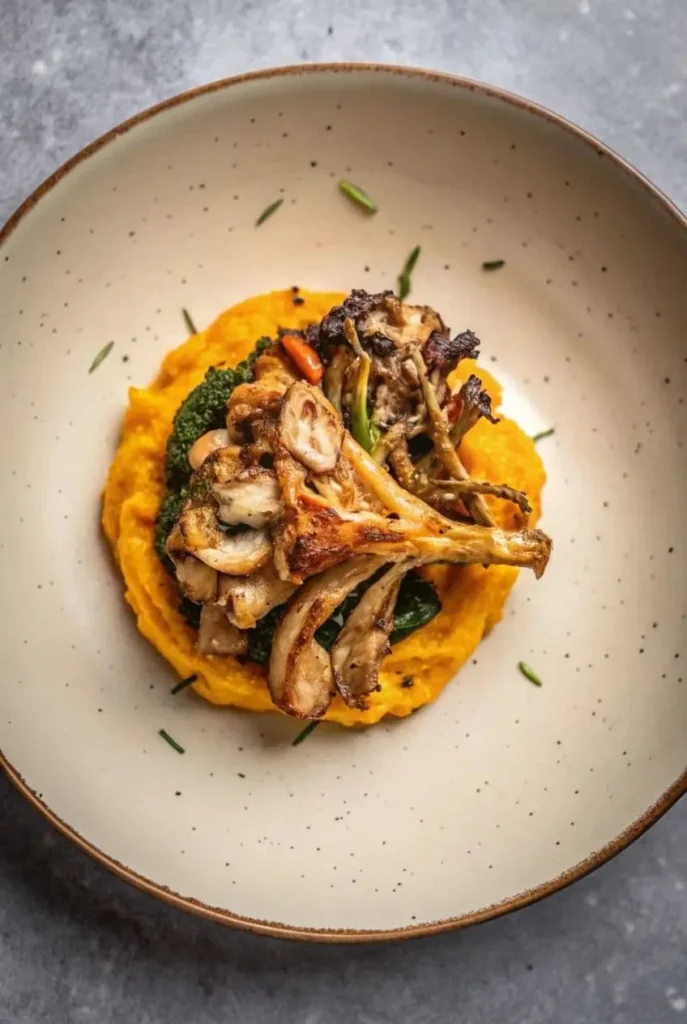
Cooking maitake mushrooms is simple, but with a few pro tips and creative variations, you can elevate this dish and tailor it to your taste. Here are some expert suggestions to make your maitake recipe even more delicious, plus some fun ways to switch things up!
Pro Tips for Perfect Maitake Mushrooms:
- Sear the Mushrooms for Extra Flavor
To achieve the perfect crispy edges and rich, caramelized flavor, make sure your pan is hot enough before adding the mushrooms. Don’t overcrowd the pan—if the mushrooms are too close together, they’ll steam instead of brown. Cook in batches if necessary for the best texture! - Patience is Key
Let the mushrooms cook undisturbed for a couple of minutes at a time to allow them to develop those golden-brown edges. The natural sugars in the mushrooms will caramelize, bringing out their earthy, umami-rich flavor. Don’t rush it! - Season in Layers
Seasoning throughout the cooking process enhances the flavor at every step. Start by seasoning the garlic, then the mushrooms, and finish with a final adjustment of salt and pepper once everything is done. This way, each layer of flavor has a chance to shine. - Use High-Quality Olive Oil
The quality of the olive oil you use will impact the overall taste of the dish. Opt for a good extra virgin olive oil that’s rich and flavorful to complement the earthy taste of the maitake mushrooms.
Flavor Variations to Try:
- Add a Touch of Creaminess
For a richer dish, stir in a splash of coconut milk or a dollop of cashew cream just before serving. This will give your maitake recipe a silky smooth texture and a subtle creamy note without overpowering the mushrooms. - Spice It Up
If you like a little heat, add a pinch of cayenne pepper or chili flakes when cooking the garlic. This will give the dish a spicy kick that contrasts beautifully with the savory mushrooms. - Herb Lovers’ Delight
Enhance the flavor with a handful of fresh herbs like thyme, rosemary, or parsley. These herbs can be added during cooking or sprinkled on top as a garnish for extra fragrance and color. - Try It with Different Sauces
Instead of soy sauce, try a splash of balsamic vinegar for a tangy twist, or a dash of miso paste for an even deeper umami flavor. These alternatives will give the dish a unique twist while still keeping it just as delicious. - Make It a Main
Transform this maitake recipe into a satisfying main dish by pairing it with grains like quinoa or farro. You can also toss the sautéed maitake mushrooms into pasta, rice, or a hearty salad for a complete meal.
Pairing Suggestions:
- With Fresh Greens
Serve the maitake mushrooms alongside a fresh, crisp salad of mixed greens. A light vinaigrette will provide the perfect balance to the savory mushrooms. - Serve with Starchy Sides
Maitake mushrooms pair wonderfully with starchy sides like mashed potatoes, roasted sweet potatoes, or even a creamy polenta. The mushrooms’ rich flavor and tender texture complement these dishes beautifully.
With these pro tips and variations, you can make your maitake recipe as simple or as adventurous as you like. Don’t be afraid to experiment with different flavors and textures to suit your preferences. The versatility of maitake mushrooms means the possibilities are endless, and each variation will bring something new and exciting to the table. Enjoy making this dish your own!
Serving Suggestions for Your Maitake Recipe
Now that you’ve perfected your maitake mushrooms, it’s time to think about how to serve them. This dish is versatile and pairs beautifully with a wide range of sides, making it perfect for any meal. Whether you’re preparing a cozy dinner for yourself or impressing guests at a dinner party, here are some delicious serving ideas to elevate your maitake recipe.
1. As a Stand-Alone Dish: Maitake mushrooms are so flavorful that they can shine on their own! Serve them in a bowl as a warm, comforting side dish, or pile them onto toast for a quick and satisfying meal. The savory umami of the mushrooms makes them hearty enough to stand alone, but they’re light enough to be enjoyed as a light lunch or snack.
2. Over Grains: Maitake mushrooms pair perfectly with whole grains like quinoa, farro, or brown rice. The earthy mushrooms complement the nutty flavor of these grains and add a satisfying richness to the dish. Serve your mushrooms over a bed of grains for a filling and balanced meal. If you’re looking for a gluten-free option, quinoa or rice are perfect choices.
3. With Roasted Vegetables: If you’re looking to create a well-rounded meal, serve the maitake mushrooms alongside roasted vegetables. Try pairing them with sweet potatoes, carrots, or brussels sprouts. The caramelized flavors of the roasted vegetables add a wonderful contrast to the savory maitake mushrooms, creating a comforting, hearty dish.
4. As a Topping for Salad: For a fresh and vibrant option, toss your maitake mushrooms on top of a simple salad. Pair them with mixed greens, arugula, or baby spinach, and top with a light vinaigrette. The mushrooms’ rich flavor will add depth and texture to the salad, while the freshness of the greens provides a nice balance. This combination is perfect for a light lunch or a side dish.
5. With Pasta: Maitake mushrooms also make an excellent addition to pasta dishes. Toss the sautéed mushrooms with spaghetti, fettuccine, or any pasta of your choice, along with a drizzle of olive oil and a sprinkle of Parmesan cheese. The earthy mushrooms blend seamlessly into pasta dishes, adding complexity and a hearty, savory element.
6. As a Pizza Topping: For something a little different, use your cooked maitake mushrooms as a topping for pizza. Whether you’re making a homemade pizza or adding them to a store-bought crust, maitake mushrooms bring an incredible depth of flavor. Combine them with ingredients like fresh mozzarella, caramelized onions, and a drizzle of balsamic glaze for a gourmet pizza experience.
Bread Pairing: To round out the meal, serve your maitake mushrooms with a side of crusty artisan bread or warm naan. The bread is perfect for soaking up any leftover sauce or juices from the mushrooms, adding an extra layer of enjoyment to every bite.
______________________________________________________________________
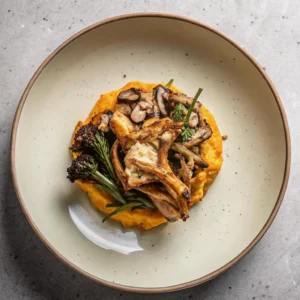
Maitake Recipe
Ingredients
Main Ingredients:
- 200 g Fresh Maitake Mushrooms – Cleaned and torn into bite-sized pieces. Fresh maitake mushrooms are essential for the best flavor and texture. If you can’t find fresh you can substitute with dried, but be sure to rehydrate them before cooking.
- 30 ml Olive Oil – For sautéing the mushrooms and bringing out their earthy flavor.
- 2-3 Cloves Garlic – Finely minced. Garlic complements the umami of maitake mushrooms perfectly.
- 30 ml Soy Sauce or Tamari for a gluten-free option – This brings a rich, umami-packed flavor to the dish.
- 1 teaspoon Lemon Zest – Adds a bright citrusy note that balances the richness of the mushrooms.
- Salt and Pepper – To taste. These simple seasonings elevate the overall flavor and bring all the ingredients together.
Optional Add-ins for Extra Flavor:
- Fresh Herbs – A few sprigs of thyme or rosemary chopped. These herbs pair beautifully with maitake mushrooms and add an extra layer of fragrance.
- Chili Flakes – A pinch if you like a little heat in your dish.
- 1 tablespoon Nutritional Yeast – For a vegan “cheesy” flavor boost sprinkle over the finished dish.
Instructions
Prepare the Mushrooms
- Gently clean the maitake mushrooms using a damp cloth or soft brush to remove any dirt.
- Avoid soaking the mushrooms in water as they absorb moisture, which can change their texture.
- Tear the mushrooms into bite-sized pieces for even cooking and to get that perfect texture.
Heat the Pan
- Place a large skillet or frying pan on medium heat and pour in 30ml olive oil.
- Allow the oil to heat for 1-2 minutes until it shimmers, signaling it’s ready for the mushrooms.
Sauté Garlic and Maitake Mushrooms
- Add the minced garlic to the hot oil and sauté for about 30 seconds until it becomes fragrant (be careful not to burn it).
- Add the torn maitake mushrooms to the pan. Stir occasionally and cook for 5-7 minutes, allowing the mushrooms to brown and become tender. The mushrooms will release their moisture, and the edges will start to caramelize, adding extra flavor.
Add Soy Sauce and Lemon Zest
- Once the mushrooms are golden brown, pour in 30ml soy sauce (or tamari if you’re going gluten-free) and toss the mushrooms to coat.
- Add 1 teaspoon lemon zest and stir to combine. The zest adds a refreshing citrusy note that balances the savory richness of the mushrooms.
- Continue to cook for another 1-2 minutes until the sauce reduces slightly and the mushrooms are well-coated.
Season and Finish
- Season with salt and pepper according to your taste, adjusting until it’s just right for your palate.
- If you like a bit of heat, sprinkle in chili flakes for a touch of spice.
- For a cheesy, vegan option, sprinkle 1 tablespoon nutritional yeast over the cooked mushrooms to add a nutty, cheesy flavor.
Serve and Enjoy
- Once the mushrooms are tender and flavorful, transfer them to a serving dish.
- Serve them as a side dish, over rice, or on toast for a quick and satisfying meal.
Pro Tips:
- Don’t overcrowd the pan! If there are too many mushrooms in the pan, they’ll steam rather than brown. Cook in batches if necessary for the best texture.
- Let them caramelize! The longer the mushrooms cook, the more flavor they develop. Don’t rush this step!
Video
Notes
- Calories: 180 kcal
- Fat: 12g
- Saturated Fat: 2g
- Protein: 5g
- Carbohydrates: 15g
- Fiber: 3g
- Sugars: 4g
- Sodium: 400mg
- Cholesterol: 0mg
- Vitamin D: 8% DV
- Iron: 10% DV
- Calcium: 4% DV
Conclusion: Why You’ll Love This Maitake Recipe
With these serving suggestions, you can create a meal that’s not only delicious but also visually appealing. Whether you prefer a simple, cozy dish or something more elaborate, the versatility of maitake mushrooms allows you to mix and match until you find the perfect combination. Enjoy experimenting with these ideas and making the recipe your own!
I hope you’re as excited to try this maitake recipe as I am! Whether you’re already a fan of mushrooms or new to cooking with them, this recipe highlights the unique, earthy flavor of maitake mushrooms in the simplest way possible. With just a few ingredients and a short cooking time, you can create a flavorful and satisfying dish that’s perfect for any occasion.
Not only do maitake mushrooms pack a nutritional punch with antioxidants, fiber, and immune-boosting properties, but they also bring a meaty texture that works beautifully in plant-based dishes. This recipe is versatile, too, allowing you to experiment with different seasonings, herbs, and sides to make it your own. Whether you’re enjoying it as a standalone dish or pairing it with grains, pasta, or roasted veggies, it’s bound to become a new favorite.
Give it a try, and don’t be afraid to get creative with your own twists. I’m sure you’ll love the rich, umami-packed flavor in every bite!
FAQs About Cooking with Maitake Mushrooms
As you prepare to cook this maitake recipe, you may have a few questions along the way. Don’t worry, I’ve got you covered! Here are some of the most common questions about maitake mushrooms, along with answers that will help ensure your dish turns out perfectly.
1. Can I use dried maitake mushrooms instead of fresh?
Yes, you can use dried maitake mushrooms, but keep in mind they will need to be rehydrated before cooking. Simply soak them in warm water for about 20-30 minutes, then drain and use as directed in the recipe. Rehydrated dried maitake mushrooms will have a slightly different texture but will still absorb the flavors beautifully.
2. Can I freeze maitake mushrooms?
Yes, you can freeze maitake mushrooms, though it may alter their texture a bit. To freeze, sauté the mushrooms first, then allow them to cool. Afterward, place them in an airtight container or freezer bag and store for up to 3 months. When you’re ready to use them, simply reheat in a pan.
3. What is the best way to clean maitake mushrooms?
To clean maitake mushrooms, gently brush off any dirt using a soft brush or a damp cloth. Avoid rinsing them directly under water, as mushrooms are porous and can absorb moisture, which affects their texture and flavor. For any stubborn dirt, you can lightly dampen a cloth, but make sure the mushrooms don’t get too wet.
4. How do I know if maitake mushrooms are fresh?
Fresh maitake mushrooms should be firm and light in color, with tightly clumped, frilly edges. The aroma should be earthy and pleasant, not musty or overly pungent. If the mushrooms are soft, slimy, or have a sour smell, it’s time to discard them.
5. Can I use other types of mushrooms in this recipe?
While maitake mushrooms offer a unique flavor and texture, you can substitute them with other mushrooms, such as shiitake, cremini, or portobello. Each will bring its own distinct flavor, but the recipe will still work wonderfully. Keep in mind that some mushrooms, like shiitake, may require a slightly different cooking time due to their density.
6. Can I make this maitake recipe without soy sauce?
Yes, if you’re avoiding soy, you can use tamari (a gluten-free soy sauce alternative) or opt for a coconut aminos substitute. Both offer a similar savory, umami flavor without the soy content. You can also try balsamic vinegar or miso paste for a different depth of flavor.
With these answers in mind, you’ll be well-prepared to create a dish that’s not only delicious but also tailored to your needs. Don’t hesitate to get creative and make this maitake recipe your own—after all, cooking is all about enjoying the process and making something you love! Enjoy the cooking journey, and feel free to experiment with different techniques and flavor combinations!

